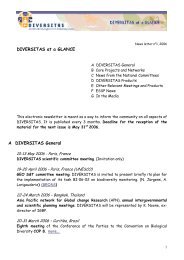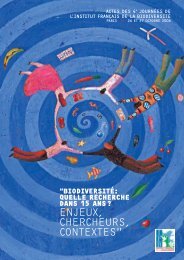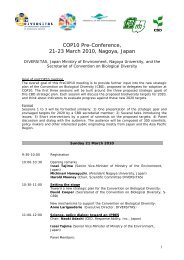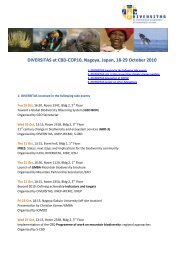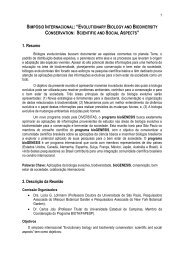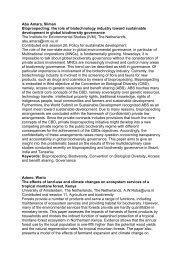Annual Report 2010-11 - Global Invasive Species Programme - GISP
Annual Report 2010-11 - Global Invasive Species Programme - GISP
Annual Report 2010-11 - Global Invasive Species Programme - GISP
Create successful ePaper yourself
Turn your PDF publications into a flip-book with our unique Google optimized e-Paper software.
ecoHEALTHBuilding bridges between biodiversity science and healthChair: P Daszak, Consortium for Conservation Medicine, Wildlife Trust, USAwww.diversitas-international.org/ecohealthThere is a growing understanding of theway environmental changes (land usechange, wildlife trade, deforestation,climate change, and others) affect thehealth of wild and domestic animals,plants and humans. These changes aredrivers of disease emergence in wildlife,humans, domestic animals and plants.Those changes will not only affect humanhealth, but will also have an importanteconomical cost.ecoHEALTH aims at providing 1) a fora tobring scientists from natural, social andmedical sciences together to address theseissues; 2) a conceptual framework to carryout research on these topics; 3) accurateinformation to decision-makers.The DIVERSITAS ecoHEALTHEconomics of Emerging Diseasesproject (DEEED)The objective of DEEED is to provide a bioeconomicmodelling framework to evaluatethe risk posed by Emerging InfectiousDiseases (EIDs) from wildlife in trade. Thisincludes formulation of the underlyingmodel describing the transport of infectedwildlife to new destinations, deriving thedistribution of the net present value forevaluating the underlying economics, andproviding a risk management strategy formaking decisions. DEEED developed a bioeconomicmodelling framework to evaluatethe risk of EIDs from wildlife in trade,and collected data from several studieddiseases to test the model.June <strong>2010</strong> and March 20<strong>11</strong> (New York,USA)DEEED organised its 3 rd and 4 th meetingto refine the model and work on twomanuscripts being in preparation.The DIVERSITAS ecoHEALTH onBiodiversity and Emerging DiseasesSubgroup (DEBED)This project is based on studies showingthat the properties of local speciesrichcommunities would protect againstinvaders and pathogens. The so-called“dilution effect” theory may representa “flag” for research on biodiversityand ecosystem services. Alternatively,papers have shown that at large spatialscales, increased biodiversity is linkedto increasing risk of zoonotic diseasesin people (disease from wildlife). Theobjective of DEBED is to develop causalinference in emerging disease ecology,in which the dilution effect phenomenonis part of something more complex:What are the main ecological drivers ofemerging infectious diseases (beforeany consideration on the possibility of adilution effect)? What does the dilutioneffect phenomenon mirror exactly?August <strong>2010</strong> (London, UK)DEBED met for the first time, back to backwith the EcoHealth conference. The groupidentified important issues related tobiodiversity change and emerging diseaseand some key issues to be addressed byDEBED as well as potential products.Science-policy activitiesJune <strong>2010</strong> (New York, USA)ecoHEALTH policy meetingSC-ecoHEALTH and representatives of theNatural Resources Defense Council (NRDC),<strong>GISP</strong>, and Conservation International heldthis meeting to review the current stateof the art on policy initiatives related tothe wildlife trade, and discuss synergisticresearch and policy agendas as well aspotential joint initiatives.Discussions with the Convention onBiological Diversity on biodiversity andhealth are also ongoing.20 DIVERSITAS I ANNUAL REPORT <strong>2010</strong>



